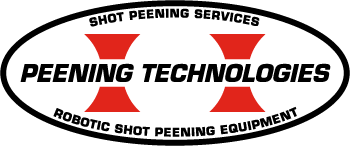Nondestructive Testing
Fluorescent Penetrant Inspection (FPI)
What is Fluorescent Penetrant Inspection?
Fluorescent Penetrant Inspection (FPI) is a sensitive, reliable, and low-cost testing method used for detecting flaws in the surface of welds, castings, forgings and other part materials without causing damage to the component under examination.
What are the advantages of Fluorescent Penetrant Inspection?
Fluorescent Penetrant Inspection has the ability to detect surface flaws in non-ferrous material. FPI is also portable, and easily managed for onsite inspections. FPI is one of the most sensitive methods for surface crack detection, and is great for detecting other surface discontinuities such as porosity.
Peening Technologies FPI capabilities
Peening Technologies of GA is compliant to ASTM E1417 and offers one of the largest fluorescent penetrant lines in the southeast, and we are capable of processing thousands of parts per day. Our main fluorescent penetrant (Type 1) line consists of ultra-high sensitivity (sensitivity 4), post-emulsifiable (Method D) penetrant. We also have the capability for visible penetrant inspection (Type II), Water Washable (Method A), and Solvent removable (Method C). We offer onsite inspections to the customer’s location, so part size is never a problem. Our NDT program is NADCAP approved, and we also have many approvals from customers in the aerospace and power generation industries.
Room size: 1,800 sq. ft
Penetrant tank size: 36” X 24” X 44”
Gallons: 150
Methods: Water Washable (A), Solvent Removable (C), Post Emulsifiable (D),
Type: Fluorescent (Type I), Visible (Type II)
Sensitivities: sensitivity 3 & 4 capability
Hydraulic lift weight cap: 500 Lbs.
How do you perform penetrant inspection?
The part surface is pre-cleaned to remove any dirt, oil, grease, paint or scale that could prevent the penetrant from entering a defect, or cause false indications. Cleaning methods can include solvents such as acetone or alcohol, alkaline cleaning, and acid etch. Penetrant is then applied to the part using an immersion tank, spray or brush. After allowing an adequate dwell time, excess penetrant is removed from the surface of the part, with extreme caution as not to remove penetrant from possible defects, and the part is dried. Next a developer is applied to the part. The developer creates a blotting action, which draws the penetrant back out of cracks and other discontinuities from which the penetrant was drawn into during the parts initial dwell time. The resulting bleed out of penetrant from flaws on the part surface will form indications that allow the inspector to identify discontinuities that will then be evaluated to customer specification. Based on the results of the evaluation, the NDT inspector will provide a report describing the type, size, and number of discontinuities found.
Peening Technologies Qualified FPI Inspectors
Our qualified NDT inspectors are highly trained in all methods of Fluorescent Penetrant Inspection, and have many years of experience in the aerospace, power generation, and manufacturing industries. Our Level II and Level III inspectors are fully qualified, hold certifications from ASNT, and meet the requirements of SNT-TC-1A and NAS-410.
Pre-Penetrant Acid Etch
Turnkey finishing capability:
Peening Technologies of Georgia is currently providing an in house pre-penetrant acid etch service. By combining Pre-penetrant Acid Etch and Penetrant Inspection, we provide the customer with a one stop shop to your finished component.
